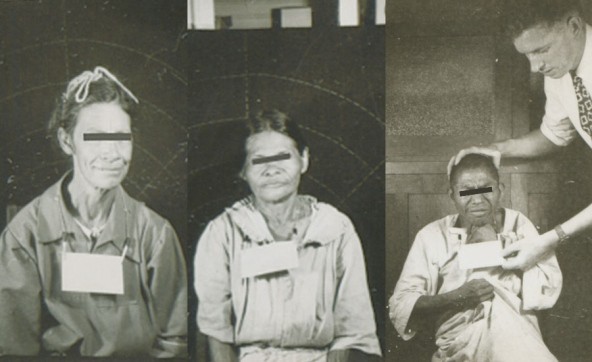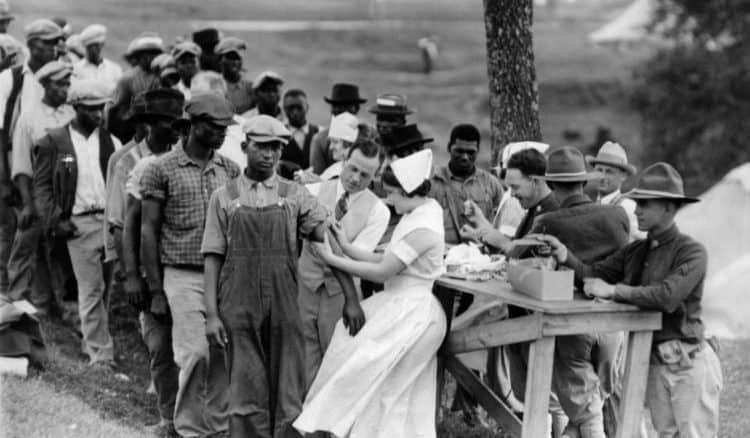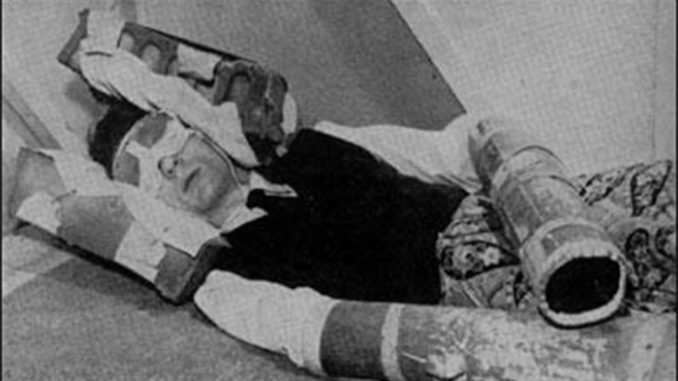Unquenchable curiosity has led to humankind’s greatest achievements. From landing on the moon to smashing atoms, the brightest minds among us have helped push scientific boundaries and move our understanding of the world forward.
But for all the scientific breakthroughs, and their benefits, such insatiable drive also casts a dark shadow; Much of the history of scientific advancement has been sullied by deceit, profit, and a callous disregard for human life. Often, it’s not until decades later that the truth is uncovered, files are declassified, and victims- if they’re still alive- have a chance at telling their stories and receive restitution.
Here, we’ll dive into six times science went wrong: From baby-deforming pills pushed by Nazis, to CIA-funded torture of depressed Canadians- all done with the approval of governments- perpetuated by the greed of pharmaceutical companies, and conducted by trusted healthcare professionals.
#1. Thalidomide: Nazi Pills

Morning sickness is the bane of many a mother-to-be; So when German pharmaceutical company, Chemie Gruenthal, marketed a pill promising to alleviate nausea in the 1950’s, thousands of pregnant women were willing to give it a try.
While Thalidomide may have taken the edge off, doctors started seeing babies born with a long list of deformities: Shortened arms and legs were the most common, but countless others suffered from “flipper” hands, missing fingers, and ear, organ, and heart problems. Over 10,000 newborns were afflicted; Thousands of others were stillborn, or became victims of infanticide, quietly killed behind the closed doors of German hospitals.
The number of adverse reactions and deformities reached a fever pitch by 1961, eventually landing nine of Gruenthal’s senior employees in court. Turns out, this wasn’t their first time in front of a judge and jury…
Twin brothers, Herman and Alfred Wirtz, founded Chemie Gruenthal a few years after the holocaust came to an end. Coming from a wealthy family, the twin, Nazi brothers were flush with cash and decided to go into the pharmaceutical business. After setting up shop, they hired a large number of Nazis to develop, test, and sell their drugs.
One such hire was Otto Ambros, the chairman of Gruenthal’s advisory board, and Nazi war criminal. Just a few years prior to working at the pharmaceutical company, Ambros (also known as the “Devil’s chemist”) was working on chemical warfare agents, including Thalidomide; Not only was it a sedative and anti-nausea medicine, it was also an antidote to caustic chemicals like sarin gas which Ambros tested on concentration camp victims. After spending a paltry three years in prison for his role in the holocaust, Ambros joined Gruenthal’s board.
Martin Staemmler, Gruenthal’s pathology expert, was a former member of Hitler’s Schutzstaffel (SS) who worked on the Nazi population program- picking “desirables” from “undesirables”.
Heinrich Muckter, another scientist hired to Chemie Gruenthal, experimented on holocaust victims in Auschwitz, Krakow, and other concentration camps.
The list of Nazis who made it on Gruenthal’s payroll was extensive, even more so than one might expect from post-WWII Germany; The extent of which wasn’t noticed until years later.
Finally, in 1968 a group of Gruenthal employees were charged with negligent homicide and injury caused by Thalidomide, though justice was never served.
By the 1970’s at least one defendant died during the trial, and Chemie Gruenthal had agreed to pay out compensation to Thalidomide victims, at roughly 100-450 German Marks per month, depending on the level of disability suffered. When Gruenthal’s trust ran out of money, the government took over responsibilty of paying restitution to victims.
No jail time was served by those responsible for the injuries, disfigurement, and deaths of Germany’s Thalidomide babies of the 20th century.
#2. Lobotomies: The 10-minute Cure-All

In 1935, Portugese neurologist, Antonio Egas Moniz, believed he developed a cure-all for many of the mental illnesses plaguing his patients. From schizophrenia to depression, mania to violent outbursts, his development of the world’s first lobotomy was set to change psychiatry.
The first iteration of the procedure involved pouring absolute alcohol into a hole bored into the brain, essentially destroying the prefrontal lobe and its connectivity to the rest of the brain.
With the help of collegue and neurosurgeon, Almeida Lima, Moniz developed a lobotomy method improving on this initial approach.
The new surgery was simple: Physicians drilled two holes in the patient’s skull, pushed a leucotome (basically a glorified icepick) through said holes, then moved the leucotomes within the brain detaching the prefrontal lobe from the rest of the structure.
The patient’s brain was scrambled eggs.
During the next decade, lobotomy was the method of choice to alleviate psychological disorders and dysfunctional behaviors. At the time, they were seen as both a massive leap in psychiatry, and the lesser of two evils; Institutionalizing patients in mental wards was common, so too was their abuse by staff. Leucotomy seemed to give patients the promise of living a more manageable life.
With the procedure taking less than 10 minutes, and the outcome (purportedly) positive, some doctors were performing upwards of 1,000 lobotomies a year in the UK and United States.
In 1949, Moniz won the Nobel Prize in Physiology for his development of the prefrontal lobotomy, though its popularity started to wane. After thousands of procedures, over fourteen years, the surgery once deemed a ‘miracle cure’ faced increased criticism.
One such criticism was that post-lobotomized patients were not given proper aftercare. Most patients were able to walk, talk, and respond to questions post-procedure, but that was the extent of any meaningful checkup. Decades later, it was found that nearly 1/3 of all patients experienced adverse results, ranging from: Apathy, lethargy, incontinence, lack of expression, epilepsy, loss of motor function, and aphasia; With another third of patients experiencing no long-lasting positive effects.
By the early 1950’s, lobotomy as the go-to therapeutic for psychiatric problems was replaced with novel pharmacological remedies. Medications were less invasive, more easily controlled, and more efficacious compared to taking an icepick to patients’ orbitals.
After two decades, the practice came to an end, leaving in its wake over 40,000 lobotomized patients; Some “cured”, while others remained irreparably damaged for the duration of their lives.
#3. STDs in Guatemala: Big Names, Big Money

From 1946 to 1948, over 5,500 Guatemalan orphans, prostitutes, prisoners, soldiers, and the mentally ill, were selected as participants in an STD study… though none of them were informed of neither the study nor their “participant” status.
A collaboration between the Rockefeller Foundation, the John Hopkins School of Medicine, and the United States government, this two year experiment on the use of penicillin for venereal diseases remained a secret for 60 years.
Guatemalan test subjects were purposefully given sexually transmitted diseases, including syphilis, gonorrhea, and chancroid. Methods of forced transmission included injecting pus from an infected man’s penis into the eyes of a female subject, scraping or scarifying subject’s foreskin then applying an emulsion with an infectious agent inside, injecting disease directly into subjects, and tricking soliders into having sexual intercourse with infected prostitutes.
Though the experiment concluded in 1948, the effects were long-lasting and multigenerational. For the victims who are still alive, they’ve not only experienced severe trauma, but some still carry the diseases purposefully given to them. Many children born to the victims are also sufferers, as diseases like congenital syphilis is passed from mother to fetus in the womb.
In 2010, Wellesley College professor, Susan Reverby, stumbled across old research papers and correspondences referencing the inhumane, clandestine experiments conducted some 60 years before. Her findings led to a class action lawsuit against John Hopkins, the Rockefeller Foundation, and the pharmaceutical company, Bristol-Myers Squibb, who supplied the penicillin to the study.
Though many victims died since the experiment ended over 60 years ago, nearly 800 survivors sued the institutional giants which subjected them to unconscionable horrors. As of 2021, litigation is still in progress.
#4. Mustard Gas: The US vs the US

Horrors of all kinds were unleashed in the wake of World War II. The United States feared more attacks by Axis nations, both by their use of traditional weapons as well as the potential threat of chemical warfare. Unfortunately, US soldiers were unaware that the most dangerous combatant wasn’t coming from a foreign country, it was their own government.
Starting in 1942, over 60,000 American servicemen were subjected to mustard gas, a cytotoxic, mutagenic, and carcinogenic chemical agent that causes blistering, burns, cancers, respiratory problems, and death. The porported purpose of the mustard gas experiments was to test the efficacy of military protective clothing and gas masks against a chemical attack, as well as find the ‘perfect soldier’.
The experiment included three different environments in which soldiers were exposed to mustard gas: Direct drops on bare skin, outdoor field tests, and closed chamber tests. Outdoor field tests were meant to mirror “real world” warfare: Mustard gas saturated the area, and soldiers’ reactions recorded. Though soldiers were given protective clothing, the results were gruesome: Moderate to third degree burns, difficulty breathing, weeks-long fevers, and skin sloughing off.
Closed chamber tests were those conducted in a sealed room pumped full of mustard gas. Soldiers were corraled into a gas chamber- some with protective gear, some exposed- and left there for at least one hour. Mustard gas permeated soldiers’ protective clothing, leaving many with severe burns. As former US soldier, Rollins Edwards, recalls, “It felt like you were on fire… Guys started screaming and hollering and trying to break out. And then some of the guys fainted. And finally they opened the door and let us out, and the guys were just, they were in bad shape.”
Caucasian soldiers were the largest demographic in the military, thus the majority of test subjects were white. However, the US government also focused on African-Americans and Japanese-Americans in order to compare reactions between different races. Not just confined to American soil, the US government also conducted this experiment on Puerto Ricans in Panama, referred to as the San Jose Project.
Secrecy kept these experiments hidden from the public for over 50 years. Soldiers were threatened by their superiors: If they were to share their experiences as government guinea pigs, it would result in a dishonorable discharge from the military. It wasn’t until 1991 that the federal government admitted to conducting the studies. Even still, they continued to hide their complicity in race-based research until 2008, when Canadian medical historian, Susan Smith, discovered materials explicitly implicating the US in such atrocities.
Still, with the experiments now declassified and survivors still alive, no compensation has been awarded.
The VA had made public promises to locate survivors, later blaming a lack of detailed record-keeping for their inability to find any. Unsurprisingly, in 2015, NPR reporters were able to locate 1,200 former servicemen involved in the experiments. But even with help of journalists, neither the VA nor any other government agency has made any attempt to contact or compensate survivors.
#5. Tuskegee: They Had “Bad Blood”

For forty years, 600 African-American sharecroppers from Alabama were unwitting participants in a dangerous, and often lethal, experiment. From 1932-1972, the Tuskegee Institute, funded by the Center of Disease Control (CDC) and the United States Public Health Service (PHS), recruited 399 syphilis-infected men, and 201 uninfected men, to study syphilis and its effects on the cardivascular and neurological systems. Although now known plainly as the “Tuskegee Experiment”, it’s official title is: the “Tuskegee Study of Untreated Syphilis in the Negro Male”.
Participants in the study were not informed of their infected status, instead, they were told they had “bad blood”; A catch-all term used to describe a wide range of diseases. Inititally, treatment was given to some participants, but when the data gathered was deemed insufficient to the researchers, they decided to forgo giving any treatment for the duration of the decades-long experiment. Even when penicillin was developed in the 1940’s, and proved highly effective, researchers withheld the antibiotic.
Syphilis is easily cured in its beginning stages by penicillin, but wreaks havoc on the body when left untreated. The disease follows four different stages, each with its own unique symptoms. The first phase, or Primary stage, is characterized by skin legions and ulcerations. Phase two, or Secondary stage, includes rashes, wort-like legions, fever, sore throat, weight loss, lethargy, kidney disease, liver inflammation, among a slew of other accompanying maladies. Stage three, Latent syphilis, is a worsening continuation of the Secondary stage. Lastly, 3 – 15 years after inital infection is the development of Tertiary syphilis. This final stage is characterized by tumor-like growths in the body (leading to deformity), neurological problems, cardivascular issues, meningitis, and other comorbidities.
During the course of the study, 128 of the 600 participants died of syphilis or syphilis-related complications.
Worse still, of those infected, many unknowingly gave the disease to their wives. Later, some of these wives infected their babies, as congenital syphilis is easily passed from mother to baby in the womb.
After 40 years of government-funded, obfuscated experimentation, the Washington Star wrote an exposé detailing the immoral and inhumane treatment of the Tuskegee test subjects. The study was shut down, and survivors filed a class action lawsuit against the federal government. In 1974, the government was forced to pay out $10 million to survivors, as well as pay for any medical expenses incurred by both survivors and family members who were also infected.
Though the federal government did pay compensation, the organization did not formally apologize to its many victims until 1997, 23 years after their experiment was exposed.
#6. McGill + Mind Control: Sanctioned Torture

Returning home after the Korean War, some soldiers appeared to be ‘brainwashed’. Accounts of soldiers regurgitating pro-communist propaganda and anti-American sentiment after being held captive piqued the CIA’s interest. Convinced that the communists had developed effective mind control techniques, the CIA was keen to develop their own. In 1957, Project MK Ultra began.
Doctors and scientists from the US and Canada were recruited from 89 universities and institutions. The CIA created foundations through which to funnel money, hiding the true source of the project’s funding. For 20 years, neither the universities, nor the scientists, were aware that they were conducting research for the CIA.
One of the most famous universities to conduct MK Ultra experiments was Canada’s prestigious McGill University. Researchers there focused their efforts on creating a “truth serum”, brainwashing techniques, and correcting mental disorders; all of which were done to unconsenting patients. Methods included dosing psychiatric patients with LSD (though this failed as a ‘truth serum’), daily electroshock therapies, forced listening of audio recordings set on a loop, medically-induced coma that would last for days, sensory deprivation, administering of paralytics, hypnosis, isolation, and sexual abuse.
One such example of what went on behind the closed doors of respected institutions, is that of Canadian psychiatrist, Dr. Donald Cameron, who conducted his studies on unconsenting patients suffering from mental illness. Cameron believed that if he could raze a patient’s mind to ground-zero and start anew, then such mental illnesses might be cured.
In order to test his hypothesis, Cameron conducted cruel experiments, including: Heavily dosing patients with LSD, inducing a coma, only to inflict extreme amounts of electroshock therapy while the patient slept. This left patients highly disoriented, often unable to control their bladders, and unable to retrieve short- and long-term memories. He referred to this as ‘depatterning’.
Once a patient was made pliable through- essentially- sanctioned torture, Cameron forced patients to listen to “positive” messages via audio loop; One phrase, repeated, hundreds or thousands of times, in order to repattern the mind into conducting more socially appropriate behavior. But these “therapies” only served to exacerbate patients’ mental illness, while also inducing severe, long-lasting trauma.
You can watch interviews with the victims here:
Such experiments were not confined to Dr. Cameron and his institution; In fact, the CIA’s MK Ultra experiments included 144 subprojects at 89 different institutions. Unfortunately, but not surprisingly, most records of MK Ultra were destroyed by former head of the CIA, Richard Helms, in the 1970’s. His destruction of evidence will forever hide the true extent to which unconsenting patients were tortured.
Though the Project was declassified in 1975, over 45 years later many survivors are still fighting for restitution and for the American and Canadian governments to acknowledge their wrongdoing. But justice, if any, is slow-coming. After eight years in litigation, nine survivors in the US were rewarded just $67,000 each. One Canadian victim, Gina Blasbalg, settled out of court, but even that came with a heavy price: Her silence. The judge handed down both a settlement and a gag order; Neither Gina nor her family will ever be able to tell her story.
As of 2021, many other survivors continue the fight for restitution, and for recognition of the torture inflicted on them by their governments.
Wrap Up
Searching for cures to the world’s illnesses is an admirable goal, though the history of science is fraught with people who use this stated motivation for darker ends.
Fueled by government monies, as well as presumably repuatable institutions like the Rockefeller Foundation and John Hopkins School of Medicine, inhumane and cruel experimentation has taken place; With studies shrouded in secrecy for decades after their completion.
The victims of such experiments rarely see justice, for the machinations of government and medicine value profit over people, and power over principle. Lawsuits waged by victims against the corporatocracy are drawn out for years, even decades; For though the truth may be with the people, the power lies with the institutions.
To believe medical deceit only occured in the past would be a grave misjudgement: Those institutions which held the reigns of power and money- governments, Big Pharma, and ‘philanthropic’ organizations- still remain at the helm today. In fact, they’re even more powerful now than they ever have been in the past.
And to that end, what grotesqueries of medical and governmental malpractice will be uncovered 50 years from now…?
Citizen Xero does NOT use Google Analytics to track readers or earn money from Google advertisers. If you find these articles helpful, please consider donating to our Cointree to help keep this site running. We gratefully accept Bitcoin and PirateChain.
Related Reading: The Real Anthony Fauci: Bill Gates, Big Pharma, and the Global War on Democracy (Robert F. Kennedy, Jr.)
Recent Posts
Humanity is entering a strange new paradigm; one in which all the rules of the game have been upended. Bubbling to the surface of our zeitgeist are earnest discussions of society’s current...
Millions of people are buying Bitcoin and leaving the dollar behind in the dust bin of monetary history. From unending money printing, to the inflation to which it inevitably leads, to governments...
